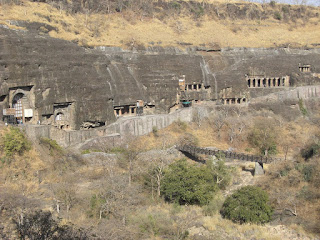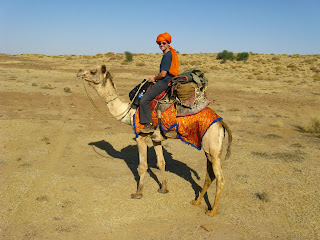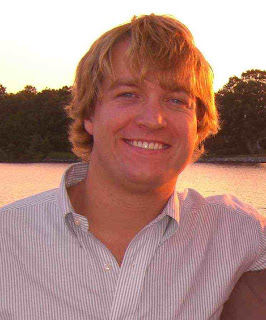 Though most people visit Goa only for the beaches, we found the winding back streets and brightly colored houses quite charming.
Though most people visit Goa only for the beaches, we found the winding back streets and brightly colored houses quite charming. Portuguese colonial rule ended in 1961 and as one of the last colonial strongholds, Goa has retained much of that influence. There may not seem to be anything special about the street above, but for India the lack of cows is notable. The effect of missionaries in Goa has not been forgotten as the area is home to one of India's highest concentrations of Christians. The Our Lady of the Immaculate Conception church (pictured below), built in 1541, is one of the town's most famous landmarks.
Portuguese colonial rule ended in 1961 and as one of the last colonial strongholds, Goa has retained much of that influence. There may not seem to be anything special about the street above, but for India the lack of cows is notable. The effect of missionaries in Goa has not been forgotten as the area is home to one of India's highest concentrations of Christians. The Our Lady of the Immaculate Conception church (pictured below), built in 1541, is one of the town's most famous landmarks. The food, however, blends the best of both Indian and Portuguese cuisine - curried fish goes well with pastries from the bakery.
The food, however, blends the best of both Indian and Portuguese cuisine - curried fish goes well with pastries from the bakery. 
We spent one day walking around town where we saw an interesting Hindu temple and a few smaller churches.

The next day we tried to take a cooking course, but unfortunately found our instructor as knowledgeable about Indian cuisine as we were. Fortunately though the extra time that day gave us the opportunity to update blogs and get in touch with loved ones.

The next morning we headed to the bus station and spent the morning on two buses, heading towards the beaches. We arrived in Palolem slightly after noon and walked through a few local's back yards before finding our hotel. The word hotel is somewhat relative as there are no real hotels, at least in the western sense, only a few people renting out bamboo shacks.

The town caters largely to tourists but there is still a local fisherman population that's not entirely tourism related. Aside from one or two businesses, there are no two storey buildings to be seen and most businesses and hotels are strictly made of bamboo.

We spent two days on the beach and one exploring nearby Patnam beach. The two beaches are nearly identical in that they are both about 2km long and crescent shaped with brilliant white sand. One of the few identifying features is the small island just at the north of Palolem right next to our hotel (see photo above), while Patnam had less defined, rocky outcroppings at both ends. Unfortunately I didn't bring my camera out until sunset at the very last night so please excuse these not so clear pictures of Palolem.
 We rented a scooter for about $5 and headed north to Patnam beach. After traveling over the same stretch of road about five times, we finally found the small turnoff for the beach and parked our bike for the day.
We rented a scooter for about $5 and headed north to Patnam beach. After traveling over the same stretch of road about five times, we finally found the small turnoff for the beach and parked our bike for the day.



The few days in Palolem and Patnam were a great way to unwind from the sensory overload that is India. Unfortunately we couldn't leave straight from the beach and had to take a bus then a bus then a taxi then a train then a taxi then a plane before we arrived in our final destination, Livingstone, Zambia more than 50 hours later. One upside of the trip was that we had enough time in Bombay to enjoy a few glasses of chai tea and dinner in our favorite restaurant before leaving the country.



































 The family patriarch spoke enough English to invite us in for chai tea. We sat around sharing our pictures of home while the children peered in curiously.
The family patriarch spoke enough English to invite us in for chai tea. We sat around sharing our pictures of home while the children peered in curiously. We rode for another hour before stopping near a small brush to escape the sun and prepare lunch. We read, ate and rested for two hours while the camels wandered around eating whatever brushes they could find. After another hour the camels stopped for water, each drinking about five gallons in as many minutes. Finally, sore and covered in dust, we arrived at our final destination - the camel races. A few thousand, mostly local, spectators had driven 40 kilometers outside the city to watch the races. Apparently 66 camels competed in the ten races but only a little over half of them ever crossed the finish line. Those that did usually barreled into a wall of spectators who hopped out of the way and merrily claimed to have been trampled by the winner.
We rode for another hour before stopping near a small brush to escape the sun and prepare lunch. We read, ate and rested for two hours while the camels wandered around eating whatever brushes they could find. After another hour the camels stopped for water, each drinking about five gallons in as many minutes. Finally, sore and covered in dust, we arrived at our final destination - the camel races. A few thousand, mostly local, spectators had driven 40 kilometers outside the city to watch the races. Apparently 66 camels competed in the ten races but only a little over half of them ever crossed the finish line. Those that did usually barreled into a wall of spectators who hopped out of the way and merrily claimed to have been trampled by the winner.


